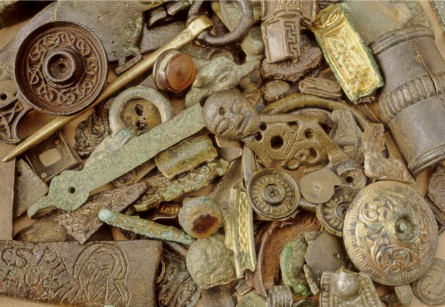The Early Christian period (c. 400-1150 AD) is the most prolific era in our past in terms of surviving archaeological sites in Ireland. By far the most common sites of the Early Christian period were earthen ráths (recorded on maps as raths, ringforts, forts or enclosures) which are the secular farmsteads of the free farmers; there are 69 ráths within the shores of Lough Neagh, the majority of them located on the northeast and eastern shore which traditionally has been the best agricultural land. (Image: Anrtrim Round Tower.)
A further 54 sites have been identified simply as ‘enclosures’ and may represent the ploughed out remains of ráths. Many of these embanked and ditched sites have been excavated revealing the layout of domestic houses, outbuildings and specialist working areas such as for iron working. Ringfort excavations have also
provided much artefact remains including domestic pottery, iron tools, wooden bowls and buckets, bone handles and pins, stone bracelets and spindle whorls. Three sites have been excavated: Shane’s Castle townland (1972), Langford Lodge in Gartree townland(1960) and Ballyshanaghill townland (1991). One structure was revealed at Langford Lodge while a total of five structures were excavated at Ballyshanaghghill. Finds from these sites include characteristic souterrain ware sherds, a complete quern topstone from Shane’s Castle, and a broken quern stone and two blue glass beads from Ballyshanaghill. ( Image: Bullock Fort, Deer Park townland. Copyright NIEA.)
The archaeology of this period is also greatly enriched by its ecclesiastical and monastic remains. This includes earthen and stone walled enclosures, churches, burial grounds, high crosses, ballaun stones, holy wells and ogham stones. Examples of such sites around Lough Neagh’s shore include Ardboe High Cross
and monastery on the western shore; the round towers at Antrim and Rams Island; and the ogham stone in Gartree townland. Elsewhere sites which proliferate include underground passages and chambers called souterrains (two souterrains are located within Shane’s Castle townland) and crannogs sites which are artificial islands constructed of wooden piles and or stones supporting a settlement platform. There are seven crannogs in the Lough Neagh area. Of the five recorded in Montiaghs townland on the southeastern shore during the 19th century only one remains; the other four are now unlocated. The other two are located in Derryloughan townland and at Toome but have no visible remains. Perhaps the most internationally renowned attribute of this period is the artwork in stone (such as Ardboe High Cross) metal and velum wherein the first written record in Ireland appears. Excavations on Coney Island between 1962-4 revealed evidence of iron working but for smithing rather than smelting i.e. the production of goods rather than the production of metal. Artefacts recovered included sherds of souterrain ware and everted rim-ware.(Image: Ardboe High Cross.)
During this period Ireland came into contact with the Vikings, following raids along the coast in the early 9th century. The Vikings (Norse) became more than raiders and eventually settled in Ireland, forming alliances with the native tribal chiefs and petty kings and laying the foundations for some of our earliest towns like Dublin, Waterford and Limerick. The Annals of Ulster record a Viking fleet under the command of Thorkils on Lough Neagh in 839AD. It stayed there during the winter of 840/41, and another fleet was present on the Lough again in 900AD. Although there is no archaeological evidence of Viking settlement on Lough Neagh shores, a horde of bronze objects recovered from dredging of the River Blackwater may be Viking booty. Further objects from the Blackwater dredging consist of 38 iron axes which were recovered from Derryloughan and Maghery townlands; some of which may be Viking. (Image: Artefacts recovered from River Blackwater. Copyright Ulster Museum.Click here to enlarge photo)




